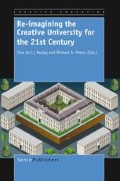Abstract
I argue the ‘Creative University’, while creative on many fronts, has not yet accessed the deepest levels of creativity relevant to a global constituency. There is a significant gap between the creativity available in Tertiary education and that practiced by a few seminal thinkers.
Access this chapter
Tax calculation will be finalised at checkout
Purchases are for personal use only
Preview
Unable to display preview. Download preview PDF.
References
Bate, J., & Rasmussen E. (2007). William Shakespeare complete works. London: Modern Library.
Cabanne, P. (1971). Dialogues with Marcel Duchamp (pp. 106–7). New York: Da Capo.
Darwin, C. (1909). The descent of man and selection in relation to sex (p. 193). London: John Murray.
De Duve, T. (1991). Pictorial nominalism: On Marcel Duchamp’s passage from painting to the readymade. University of Minnesota Press.
Ebenhof, A. Bacon (Shakespeare) and Friedrich Nietzsche. www.sirbacon.org/nietzsche.htm. (Accessed 22.06.04).
Greer, G. (2007). Shakespeare’s wife. London: Bloomsbury.
Honderich, T. (1995). The Oxford companion to philosophy (p. 379). Oxford: Oxford University Press.
Humphreys, A. (1971). Henry VIII (p. 20). London: New Penguin Shakespeare.
Jones, P. (1977). Shakespeare Casebook. London: Macmillan.
Loye, D. (2000). Darwin’s lost theory of love. Lincoln: toExcel.
Moore, M, (2012). Marcel Duchamp and New Zealand art, 1965–2007. Wellington: Victoria University. PhD Thesis.
Paz, O. (1970). Marcel Duchamp or the castle of purity. London: Cape Goliard Press.
Pears, D., & McGuiness B. (1961) Trans. Ludwig Wittgenstein, Tractatus Logico-Philosophicus. London: Routledge and Kegan Paul.
Peters, R. (2005). William Shakespeare’s Sonnet philosophy. Kaponga: Quaternary Imprint.
Rhees, R. (1981). Drury, M. Conversations with Wittgenstein. Ludwig Wittgenstein, Personal recollections. New York: Rowman and Littlefield, 160.
Tomkins, C. (1998). Marcel Duchamp (p. 465). New York: Owl Books.
Author information
Authors and Affiliations
Editor information
Editors and Affiliations
Rights and permissions
Copyright information
© 2013 Sense Publishers
About this chapter
Cite this chapter
Peters, R. (2013). Toward a Quaternary Level of Creative Education. In: Besley, T., Peters, M.A. (eds) Re-imagining the Creative University for the 21st Century. Creative Education Book Series. SensePublishers, Rotterdam. https://doi.org/10.1007/978-94-6209-458-1_13
Download citation
DOI: https://doi.org/10.1007/978-94-6209-458-1_13
Publisher Name: SensePublishers, Rotterdam
Online ISBN: 978-94-6209-458-1
eBook Packages: Humanities, Social Sciences and LawEducation (R0)

